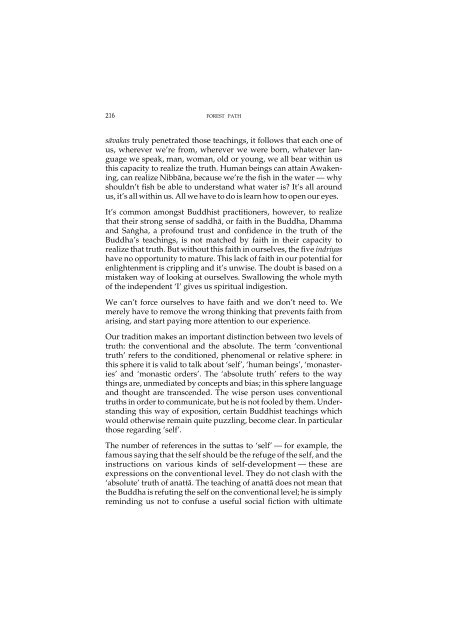Forest Path - Amaravati Buddhist Monastery
Forest Path - Amaravati Buddhist Monastery
Forest Path - Amaravati Buddhist Monastery
Create successful ePaper yourself
Turn your PDF publications into a flip-book with our unique Google optimized e-Paper software.
216 forest path<br />
sàvakas truly penetrated those teachings, it follows that each one of<br />
us, wherever we’re from, wherever we were born, whatever language<br />
we speak, man, woman, old or young, we all bear within us<br />
this capacity to realize the truth. Human beings can attain Awakening,<br />
can realize Nibbàna, because we’re the fish in the water — why<br />
shouldn’t fish be able to understand what water is? It’s all around<br />
us, it’s all within us. All we have to do is learn how to open our eyes.<br />
It’s common amongst <strong>Buddhist</strong> practitioners, however, to realize<br />
that their strong sense of saddhà, or faith in the Buddha, Dhamma<br />
and Saïgha, a profound trust and confidence in the truth of the<br />
Buddha’s teachings, is not matched by faith in their capacity to<br />
realize that truth. But without this faith in ourselves, the five indriyas<br />
have no opportunity to mature. This lack of faith in our potential for<br />
enlightenment is crippling and it’s unwise. The doubt is based on a<br />
mistaken way of looking at ourselves. Swallowing the whole myth<br />
of the independent ‘I’ gives us spiritual indigestion.<br />
We can’t force ourselves to have faith and we don’t need to. We<br />
merely have to remove the wrong thinking that prevents faith from<br />
arising, and start paying more attention to our experience.<br />
Our tradition makes an important distinction between two levels of<br />
truth: the conventional and the absolute. The term ‘conventional<br />
truth’ refers to the conditioned, phenomenal or relative sphere: in<br />
this sphere it is valid to talk about ‘self’, ‘human beings’, ‘monasteries’<br />
and ‘monastic orders’. The ‘absolute truth’ refers to the way<br />
things are, unmediated by concepts and bias; in this sphere language<br />
and thought are transcended. The wise person uses conventional<br />
truths in order to communicate, but he is not fooled by them. Understanding<br />
this way of exposition, certain <strong>Buddhist</strong> teachings which<br />
would otherwise remain quite puzzling, become clear. In particular<br />
those regarding ‘self’.<br />
The number of references in the suttas to ‘self’ — for example, the<br />
famous saying that the self should be the refuge of the self, and the<br />
instructions on various kinds of self-development — these are<br />
expressions on the conventional level. They do not clash with the<br />
‘absolute’ truth of anattà. The teaching of anattà does not mean that<br />
the Buddha is refuting the self on the conventional level; he is simply<br />
reminding us not to confuse a useful social fiction with ultimate

















